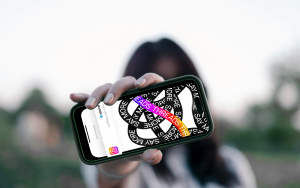

Instagram! Instagram! Instagram! Everywhere…. Who doesn’t have an Instagram account lately? Most of us have, right?! It serves as a potential platform to gain name and fame from your target audience. It’s been a fantastic platform for showcasing the incredible talents of content creators, as well as a brilliant way to promote your brands and businesses.
How often do you use Instagram? Almost every day? Because it keeps you engaged with the most enticing content that you may want to see! Using the best of technology, Instagram personalizes your experience and makes it worth your while and never ceases to amuse you!
But still many of us are clueless about its algorithm. Instagram has a flabbergasting algorithm that shows content that you will possibly like and share, depending on your interests. Well, how did they manage to amass that data about your likes and dislikes?
This blog will shed more light on how Instagram’s technology works and how it impacts the experiences that people have across the app.
One of the biggest misconceptions about Instagram is that it doesn’t use just one algorithm that oversees your activities on the app. It uses a variety of algorithms, processors, and classifiers each with a different purpose. Each one gets a feed that ranks posts based on what you care about most.
Each section of the app – Feed, Explore, and Reels – has an algorithm that is adapted to how users interact with it. People tend to hunt for their closest friends in Stories, but they desire to discover something completely new in Explore. In different portions of the program, Instagram ranks things differently depending on how people use them.
Individuals use Feed and Stories to see content from their friends, family, and other people they care about. Any ranking algorithm may be broken down into steps to know how it works.
Instagram decides what to rank first. It’s very simple with feed and stories as it’s all the recent posts shared by the people you follow on your account.
Next, it uses all the information on what the post was about, the people who made those posts, and your preferences. These are referred to as “signals,” and there are tens of thousands of them. They cover anything from when a post was shared to whether you prefer to watch videos on your phone versus on the computer. In roughly descending order of significance, the most important signals across Feed and Stories are:
Gathers signals like how interesting the person is to you and how often you have engaged with that person’s posts.
These are a set of predictions that helps Instagram guess your likes and dislikes based on your interactions and engagements in your feed, explore and reels content in different ways. How likely you are to spend your time on the post, comment on it, like it and save it all counts to the signals. Instagram weighs your action based on your interactions with the content, and that’s pretty much the first set of posts you will likely see when you open the app.
Instagram also Condemns your act if you violate community rules that vandalize an individual’s safety.
This is the section where you see content from accounts you don’t follow as well. This also works the same way. It first shows you a set of reels that you might probably like. Based on your actions, the algorithm guesses the kind of content you will entertain you with.
1) Your Activity: Based on your actions weighed, Instagram shows content that might be of relevance to you.
2) Your Interactions with people who have posted: Your interaction gives a sense of your interests with the people you probably never came across in your explore tab.
3) Information about the reel: These are the signals of the soundtrack and the audio, the duration, video quality based on the pixel clarity and popularity of the content.
Adding more insight to how Instagram material is ranked, displayed, and filtered is only one part of the puzzle. Instagram also assists you in customizing your experience depending on your preferences. For businesses and creators, especially the best digital marketing company in Bangalore, these insights are crucial to build strong Instagram strategies.